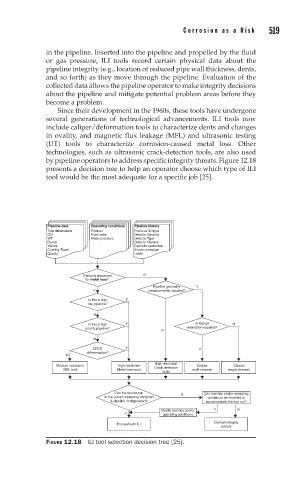Page 556 - Corrosion Engineering Principles and Practice
P. 556
518 C h a p t e r 1 2 C o r r o s i o n a s a R i s k 519
in the pipeline. Inserted into the pipeline and propelled by the fluid
or gas pressure, ILI tools record certain physical data about the
pipeline integrity (e.g., location of reduced pipe wall thickness, dents,
and so forth) as they move through the pipeline. Evaluation of the
collected data allows the pipeline operator to make integrity decisions
about the pipeline and mitigate potential problem areas before they
become a problem.
Since their development in the 1960s, these tools have undergone
several generations of technological advancements. ILI tools now
include caliper/deformation tools to characterize dents and changes
in ovality, and magnetic flux leakage (MFL) and ultrasonic testing
(UT) tools to characterize corrosion-caused metal loss. Other
technologies, such as ultrasonic crack-detection tools, are also used
by pipeline operators to address specific integrity threats. Figure 12.18
presents a decision tree to help an operator choose which type of ILI
tool would be the most adequate for a specific job [25].
Pipeline data Operating conditions Pipeline history
Trap dimensions Product Previous ILI/type
OD Flow rates Defects: Severity
WT Mean pressure Defects: Type
Bends Defects: Number
Valves Cathodic protection
Coating: Type/ Known corrosion
Quality Leaks
Primarily inspection N
for metal loss?
Pipeline geometry Y
Y measurements required?
Is this a high Y
risk pipeline?
N
Is this a high Y Is feature N
priority pipeline? orientation required?
N
N
OD/ID Y Y
differentiation?
N
High resolution
Medium resolution High resolution Caliper Caliper
MFL tool Metal loss tools Crack detection multi channel single channel
tools
Can the tool be run Can facilities and/or operating
in the current operating condition N conditions be modified to
& pipeline configuration? accommodate the tool run?
Modify facilities and/or Y N
Y operating conditions
Proceed with ILI Consult integrity
advisor
FIGURE 12.18 ILI tool selection decision tree [25].

